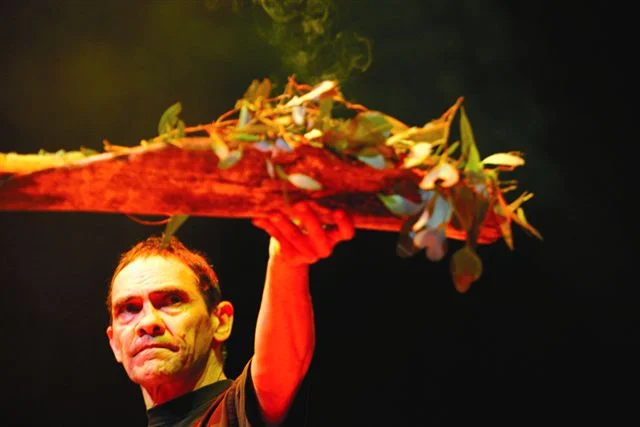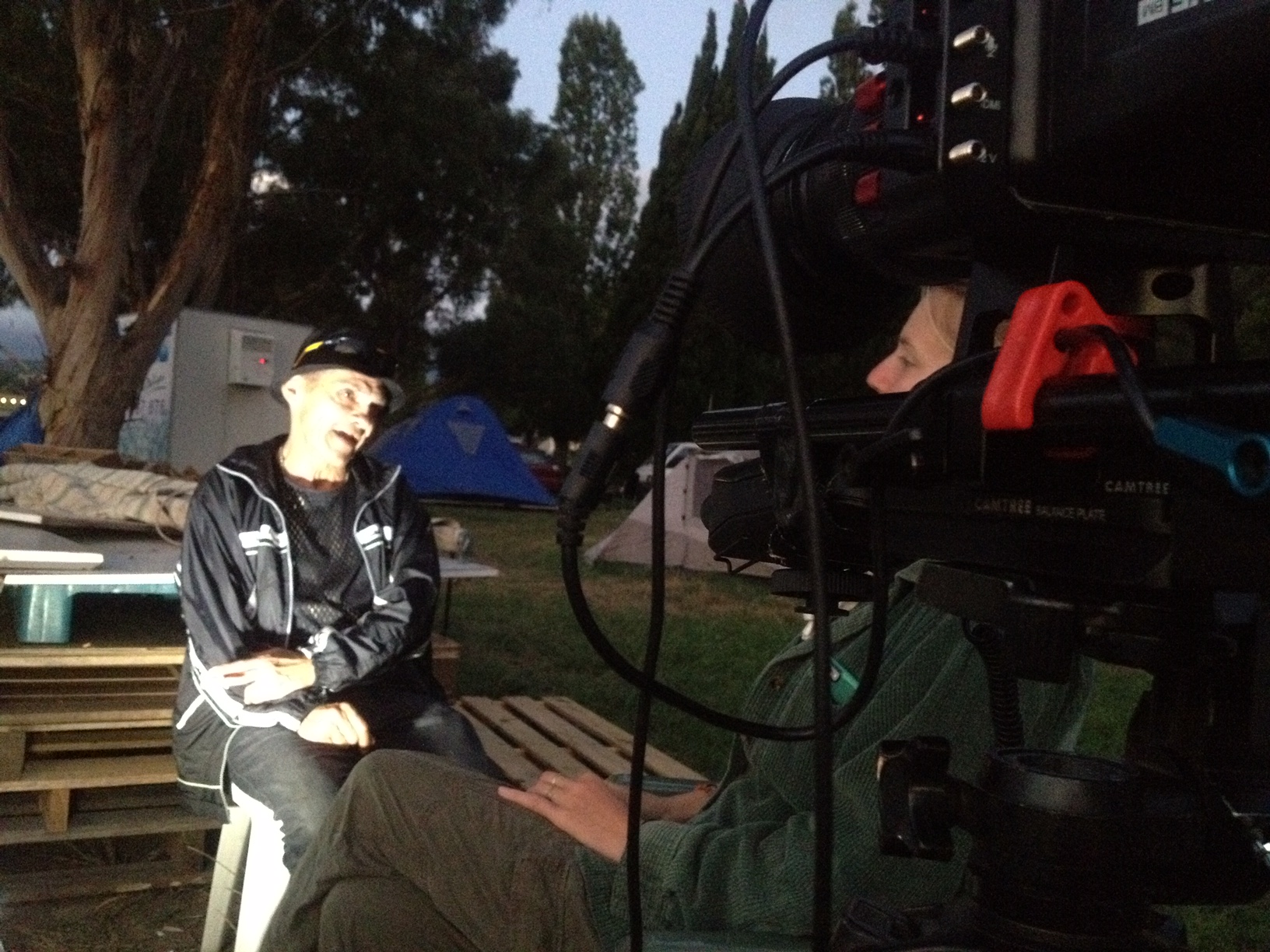Directors notes
Robbie being interviewed by Charles Pakana 3KND
Shoot at the 38 Nation Rally - September 2018
Interview at the Aboriginal Tent Embassy - Canberra January 2017
Director, Robbie and Medika Thorpe at a production meeting 2019
I am a Melbourne based independent documentary filmmaker and editor but it is through decades of peace, environment and social justice activism that I got to know Robbie Thorpe.
I first met Robbie around 1989 when he would attend activist meetings around Melbourne arguing for us to join the Pay the Rent campaign – in which non-indigenous people would contribute a small percentage of their income to Indigenous controlled organisations or campaigns, which would then provide an independent economic base for Aboriginal resistance. Pay the Rent exemplified Robbie’s strategic vision - as a tactic it was brilliantly constructive. It emphasized independence, practical solidarity, and drove home Robbie’s key messages that Indigenous Sovereignty was never ceded, nor was a there any form of treaty and that all non-indigenous people in Australia are living on the proceeds of an horrific, illegal and premeditated act of genocide.
But Pay the Rent was only one of Robbie’s campaigns. In 1990 Robbie appeared at the newly established ATSIC (Aboriginal and Torres Strait Islander Commission) offices in Gertrude street, Fitzroy dressed in full traditional garb, painted up, with spears and a possum skin cloak. ATSIC had been condemned by many of the radical Indigenous networks as another form of assimilation. Robbie walked into the ATSIC office and inside, he re-dressed slowly in a business suit. He painted his face white, picked up a briefcase and walked out again to the glare of media cameras.
In 1991, Robbie ceremoniously marched to the statue of Melbourne’s revered ‘Founding Father’ John Batman in Collins Street and, before a crowd of several hundred people, proceeded to put him on trial for crimes against humanity, genocide and murder. The statue’s hands were made red – his crimes were listed and hung around the statue’ neck.
I witnessed this form of expertly conceived, theatrical, deeply symbolic protest action from Robbie over the next two decades.
In 1997, Robbie, then a 39-year-old, Melbourne University law student walked into the Melbourne registry of the High Court and began the process of taking Australia to the World Court to decide who has the right to hear and decide cases involving sovereignty over the land known as the Commonwealth of Australia.
On Invasion Day 2003 a tall ship appeared at a St Kilda beach and, again in the full glare of news camera’s Robbie declared that the new arrivals would be welcome if they respected sovereignty and the law and agreed to pay the rent for their stay. The Captain and officers who refused were put back on their boat and sent packing, the crew and convicts who agreed were welcomed according to the Eastern Kulin Nation tradition of Tanderrum. It was history as it should have been – instilled with the sense of justice and right that Robbie relentless espouses.
Photo: Dominic Buckley 2017
In 2006 he was again in the international spotlight with the 60-day Camp Sovereignty during the Melbourne Commonwealth Games, which Robbie rebranded as the StolenWealth Games and declared the Black GST (Genocide to end, Sovereignty acknowledged, Treaty to be made).
Robbie’s actions have attracted criticism from Prime Ministers, Premiers, Andrew Bolt, and even other Aboriginal activists, including Elders.
To me, Robbie has been a primary educator. I’ve listened to and learnt from Robbie throughout my work as a social justice and human rights campaigner. I know Australia is a crime scene and I know why. Robbie draws the threads of two centuries of oppression together by relentlessly focusing our attention on the core injustices. I believe that Robbie’s messages are critical to modern Australia. I want to explore why and examine his political impact as an activist.
I have been interested for many years in how Robbie sustains himself against such great odds. What drives him to continue to resist colonialism in a country that was occupied 227 years ago? His public rhetoric is powerful and relentless but I want this film to provide a sense of who he is and the forces that shaped him.
As a filmmaker I have an opportunity to forefront important and under-heard narratives. The issues of sovereignty and treaty raised by Robbie are vital to me not only as a social justice activist but also as a citizen of this colonial-settler nation state which we call Australia. Through this film I will be continuing to interrogate my place as a non-indigenous Australian, a process that began in late high-school, and also taking a place amongst a long line of non-indigenous filmmakers depicting, documenting and collaborating with Indigenous artists activists and communities.[i]
From patronizing and racist ethnographic films to more recent powerful collaborations, non-indigenous filmmakers seem to be getting better at respecting and working with Indigenous subjects and subject matter. As a non-Indigenous filmmaker respect, consent and appropriate cultural pathways[ii] are vital. I’m committed to extensive and continuing consultation with all subjects. Good observational documentaries are based upon listening and a high level of trust and respect between maker and subject, which tend to be basis for solidarity work in any context.
I have drawn much from Clare Land’s 2015 book Decolonising Solidarity [iii] which reckoned with much of the tensions, dilemmas and complicity of my own activist and movement based experience and emphasised critical self-reflection, acknowledging intersectionality and the need to act politically.
I hope this documentary comes close to meeting Lester-Irabinnna Rigney’s definition of ‘Indigenist research’ - which is research that is culturally safe and respectful and follows three principles: that it is guided by resistance as an emancipatory imperative, that it has political integrity, and that it privileges Indigenous voices. These principals have informed my research, production and editing throughout.
David McDougall (Whose Story is It?, 1998), says that “If a film is a reflection of an encounter between filmmaker and subject, it must be seen to some degree as produced by the subject.” In this work I have emphasized the voice of each subject as primary – and eschewed narration or interpretation – whilst remaining cognizant of each an every editing choice throughout. McDougall also notes that films arising from a dialogues between a filmmaker and subjects of a fundamentally different culture can end up being read by each party as expressing different things. I would expect this documentary to be read very differently by Indigenous and non-Indigenous audiences.
Despite these resources and influences, fuck-ups in this film and during its more than eight years of production are very much my own.
Through this film I have looked for ways to interpret, communicate, depict the struggle that Robbie articulates to audiences beyond those already engaged. I will be looking to ways to maximize its social and political impact.
I want to thank Robbie for sticking with this project and his patience as year after year went by. I also wish to thank the entire Thorpe family for their support, trust and extraordinary generosity of spirit.
Anthony Kelly, January 2025
The FCPX edit timeline at first assembly October 2018
[i] See Fitzsimmons, Trish, Australian Documentary: History, Practices and Genres. Cambridge University Press 2011
[ii] Screen Australia’s Pathways & Protocols http://www.screenaustralia.gov.au/filmmaking/Indigenous_protocols.aspx
[iii] Land, Clare, Decolonizing Solidarity: Dilemmas and Directions for Supporters of Indigenous Struggles. Zed Books Ltd, 2015







